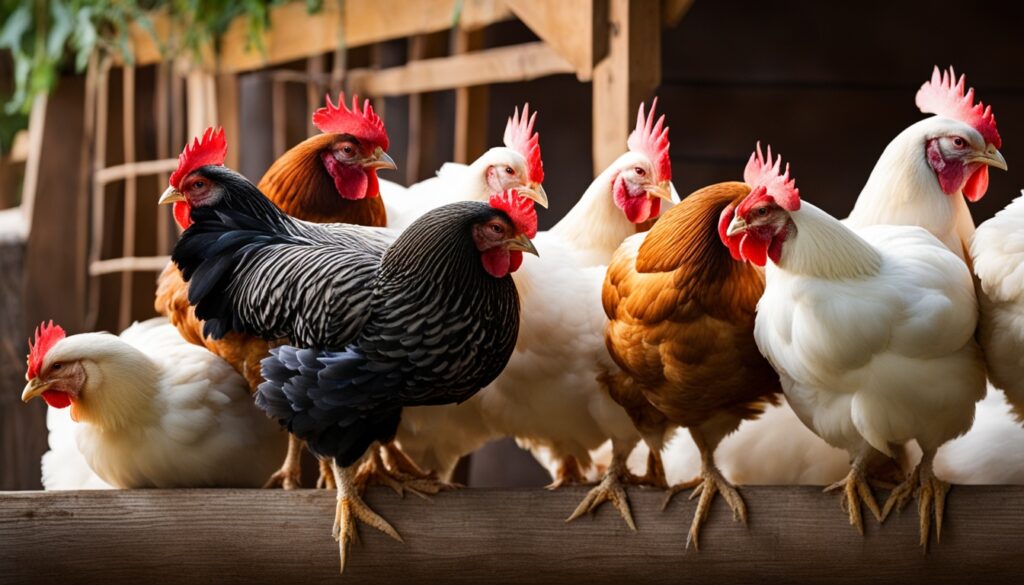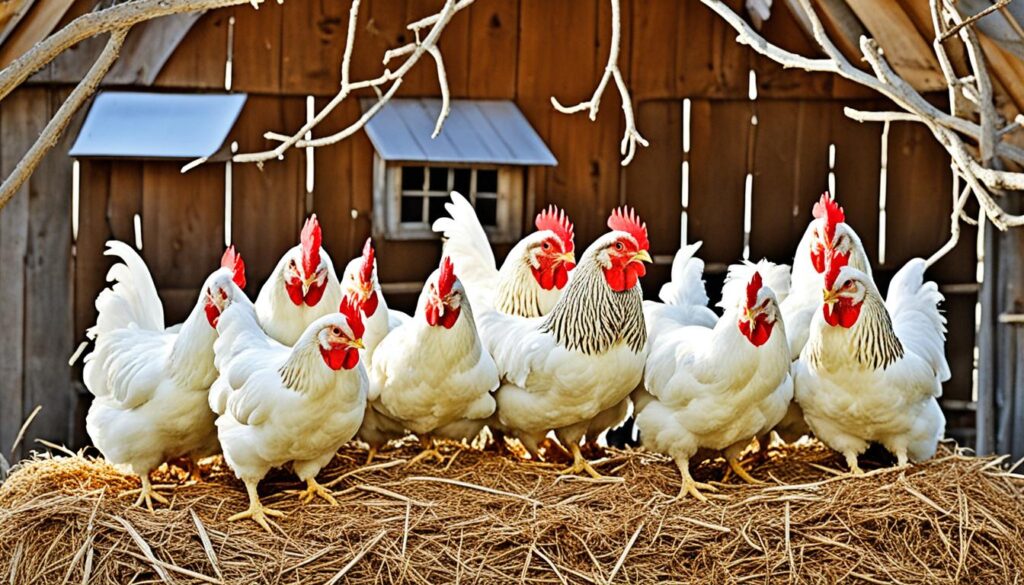Chickens started roosting high up over 5000 years ago. They looked for safe places away from predators. A roost is a spot, like a branch, where they sleep off the ground. This keeps them safe and makes them feel secure.
Today, about 19 billion chickens live on our planet. They still love to roost high, especially the top chickens in the group.
Roosting isn’t just a habit for chickens; it’s key to their health. Without the right roosts, they might sleep in nest boxes. This can cause dirty nests and egg problems. It also means they might sleep on the ground, which is bad for their health because of bugs and germs.
The best practice is to have roosts at least 18 inches high in their homes. This makes chickens feel safe while they sleep. It also keeps them safe from other animals in the coop.
Key Takeaways:
- Chickens naturally seek high roosts for safety from predators.
- Roosting is essential for chickens’ health and well-being.
- Proper roosting space prevents soiled nests and potential egg-eating behaviors.
- Roosts should be placed 18 inches or higher from the ground within a coop.
- Chickens may take some time to adjust when new roosts are added to existing coops.
The Importance of a Roost for Chickens
Chickens need a place to roost for several reasons. They used to roost high to stay safe from predators. Today, even though most chickens are safe from predators, they still roost for safety and warmth. They also get comfort by roosting with their flock mates.
In a chicken coop, having a roosting area is very important. Without it, chickens can face health problems. For example, they might get sick from parasites and bacteria on the ground. Adding roosting bars gives chickens their own space to sleep at night.
For good roosting, chickens need about ten inches of space each. You might need less space for smaller chickens. The roost should be about 18 inches off the ground. This is because chickens like to roost high up. It makes them feel safe and can reduce their stress.
When you add new roosts, give the chickens time to get used to them. They might not use the new roosts right away. But, being patient and keeping things the same each night will help them accept the new roosts.
Starting young chickens off with a roost helps. When baby chicks have a roost in their brooder, they get used to roosting. They’ll continue this habit as they get older. This can be a lifelong habit for them.
Chickens like to roost high because it feels safe for them. Make sure the roost is at least 45cm from the ground. A good roost is made from smooth, sturdy wood. This keeps chickens from getting hurt while they sleep.
Don’t put the roost over the nesting boxes or feeders. This can keep the area cleaner. A clean and well-arranged roosting area is key to chicken happiness and health. It makes a better life for your birds, keeping them comfortable and healthy.

Building a Chicken Roost
Building a safe and comfortable chicken roost means looking at a few key things. Think about where you’ll put it. It should be away from places like entrances and nesting boxes. Also, pick materials that are stable and safe for the chickens to stand on.
When it comes to materials, you have many options. Things like strong branches, rubber poles, or a 2×4 work well. Choose things that are not slippery and are easy to keep clean. This avoids any issues for the chickens.
Make sure there’s enough space for each chicken to roost. They need about ten inches each. This helps keep them comfortable and the roosting area clean. By using different heights for the roosting bars, you can keep the area healthier.
The design of your roost matters. You could go for a ladder or a tree branch style. Whatever you choose, make sure it’s strong and safe for the chickens. And, it should be at a good height they can easily get to. Consider your space when deciding how many roosts to make.
Materials and Assembly
Choosing the right materials is important, depending on your design. Things like 2x6x10 lumber are often used. Make sure to sand the wood for safety. Cutting angles for brackets can make the roost stronger and more stable. Staining the wood not only looks nice but also protects it from moisture.
Putting the roost together can be done using different methods. Ropes, screws, or zip ties are good options. Ropes look good and can be adjusted easily. Screws are strong and keep the roost in place. Zip ties are easy to use and remove when needed.
Remember, it might be hard to move the roost once it’s built. So, build it inside the coop if you can. Think about the space and layout to make it fit well.
Chickens really enjoy using a well-made roost. A good roost keeps them healthy and happy. So, make a roost that’s safe from predators. Your chickens will thank you for it.

Roosting Habits of Chickens
Chickens like to find a high-up and safe place to sleep at night. This habit has been around for over 5000 years. They roost high to stay away from predators. Even though many chickens now live in safe areas away from predators, they still like to roost high up.
It’s key for chickens to have enough space to roost for their health. Without roosting spots off the ground, chickens may catch parasites. To make them feel at home, roosts in chicken coops should be at least 18 inches off the ground.
When you add new roosts to a coop, chickens might not use them right away. But, with time and watching, they will start using the new roosts.
Coop Training and Roosting
Training chickens to roost in a specific place can be done. Keep them in the coop for at least a week, without letting them out. This makes them used to the coop and wanting to roost inside.
It works best when chickens are young, but older chickens can learn too. Never coop-train if it’s too hot inside, as it might stress them.
After a few weeks in the coop, let the chickens out to roam during the day. They learn to come back to the coop at night. This helps keep their roosting habits strong.
The Importance of Safe Roosting Spaces
It’s really important to offer chickens a safe place to sleep. This way, they won’t sleep where they lay eggs, keeping them clean. Good roosting areas also stop them from laying eggs in hidden spots.
Using wide pieces of lumber as roosting bars helps protect chickens in the cold. They keep chickens off the cold ground and prevent frostbite.
Chickens like to sleep near each other, which keeps them warm and makes them feel safe. This behavior also helps with their sense of community.
By knowing about and providing for chickens’ roosting needs, you can help them sleep well and stay healthy.

How Chickens Sleep
Chickens have their special ways of sleeping. They aim for about 8 hours every night and want to sleep through the night. When sunset arrives, they find their cozy spots to rest for the night.
Chickens can even have dreams during their REM sleep. You might see them move or hear them make sounds. This hints that they could be dreaming just like us.
Chickens can be quite the watchful sleepers. They can keep one eye open to stay safe from any nearby dangers. This lets them rest while staying alert, using a cool trick where each eye is linked to a different brain half.
Where and how chickens sleep is very important. Loud sounds, light, and extreme temperatures can disturb their sleep. This includes artificial light. Making their sleeping area calm, dark, and quiet is crucial for their happiness and health.

For a good night’s sleep, wooden roosting bars in chicken coops are the best. These bars keep chickens off the ground, away from sickness. They should ideally be 2 to 4 inches wide, fitting both kind of chicken sleep needs.
The roosting bars should be just right in length. At least 8 inches per hen is good for them to keep warm by snuggling. The roosts can be high up, but make sure they’re safe. Staggered stairs can help if they’re above a foot high.
Cleaning these bars regularly is a must for a clean coop. Chickens don’t stop using them to rest even when they’re sleepy. Use a metal scraper on them often, and clean with a vinegar mix now and then. Don’t forget to space the roosts 15 inches apart to stay clean.
Finally, make sure the nesting boxes are below the roosts. This helps keep the eggs clean, since chickens won’t sleep in the nesting boxes this way.
Sleeping Habits of Chickens
Chickens have unique sleep patterns that show how they stick close to their natural ways.
These birds enjoy being together when they sleep, finding comfort and warmth in the group. It’s not just about warmth; they feel safer from any nightly threats in their huddle. This way of sleeping also helps keep watch for predators while they rest.
Chickens pick buddies to sleep near. They make sure to form a strong, protective circle at bedtime. It ensures everyone is safe from danger during the night.
Like us, chickens also need a peaceful night’s sleep, getting about 8 hours of rest. It’s important for them to recharge for the new day ahead.
Chickens go through different sleep stages, including REM and non-REM sleep. REM stage might mean they dream, just like we do during that phase of sleep.
Now, here’s something really interesting: chickens sleep with one eye open. Their eyes are connected to different parts of the brain. This way, they can remain on the lookout for predators while resting.
The right sleeping conditions matter a lot to chickens. They follow the natural light for their sleep. But, too much artificial light can mess up their sleep cycle, affecting their health.
To help chickens sleep well, we must give them a cozy place. A good roost, high off the ground, makes them feel secure. This stops them from choosing bad sleep spots, like dirty areas.

Unique Roosting Behavior in Chickens
Chickens love to roost high up. It keeps them safe from predators. In the wild, they perch on treetops up to 40 feet high. This habit shows how much they like being up high.
It’s key to set up good roosts for your chickens in their coop. Make sure the roosts are at least 18 inches off the ground. This makes chickens feel safe and comfortable.
Chickens also like to compete for the best roost spot. The top chickens claim the highest spot. This shows who’s boss in the chicken group.
Having high places for chickens is great. It helps them feel safe and sleep well. This is important for their happiness.

It’s vital to build roosts that meet the chickens’ needs. Use sturdy wood for the roosts. This makes them safe and comfy for the chickens.
The roosts should be at least 2 inches wide. But, 4 inches is better for gripping. Leave 8 inches of space for each hen to roost comfortably.
Roosts can go at different heights in the coop. They can be low, even right on the ground, or high near the ceiling. This lets you adjust the coop to fit your birds.
Strong and well-made roosts lower the risk of chicken injuries. They help keep your chickens healthy. This is very important for them.
Clean the roosts often because of chicken droppings. Use white vinegar and water to clean. Keep roosts at least 15 inches apart to stop droppings from falling on each other.
By providing the right roosts, you can make your chickens happy and healthy. A good roosting space is very important for them.
Conclusion
Roosting is crucial for chickens. It gives them a safe, cozy place to sleep at night. Knowing what chickens like in a roost helps their keepers make a good one. This way, the chickens stay happy and healthy.
Hens like to roost up high, especially the top hen. But, roosts shouldn’t be higher than 1 meter. This keeps their feet safe from getting hurt. Chicken buddies need enough space on the roost, around 14 cm each. This stops fights and pecking.
It’s smart to make roosts out of wood. Wood is easy to grip and stops slipping. The best size for a perch is about 2 inches across. This gives chickens a good hold. The perch should be smooth and either round or a little oval. This makes it comfy for their feet.
Putting the roost higher than the nest boxes helps. It stops chickens from sleeping where they shouldn’t. Too many chickens on a roost is bad. It can stress them out and cause health problems. Good roosts from well-known brands like Coops and Cages and Somerzby make life better for chickens.
